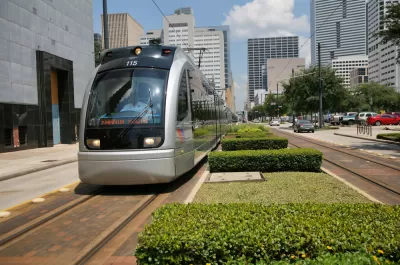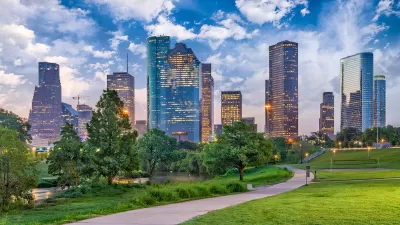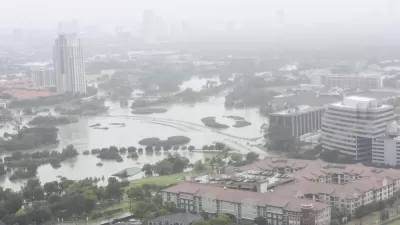Finally, the city seems to be reaping benefits from a major investment in public transportation.

Light rail has been an important (and expensive) part of urban development in both Dallas and Houston, two cities better known for sprawl than vibrant density.
In Houston, at least, two recent studies show that rail was a sound investment, notes Dian Nostikasari at Rice University’s The Urban Edge.
The first, from Texas Southern University, concluded, “[T[here have been measurable positive impacts from the development of light rail, at least on the Main Street corridor.”
The second, from one researcher with the Washington State Department of Transportation and another from the Texas A&M Transportation Institute, “examined changing land use within approximately half-mile of the rail stations along the original red, purple and green line in Houston.”
“That study found that along the original red line, there was a rise in commercial development that happened after the light rail came in but that began even before the red line was constructed. The study also found, increased development on vacant lands along these rail lines. This is a good thing as vacant land in cities like Houston tends to represent a lack of investment. Even as the Houston region continued to face a shortage of affordable housing supply, residential units along these rail lines increased – a trend across the country as living close to transit becomes a more attractive option.”
After many years of resistance to investing in public transit, light rail in Houston has been well received, as has the city’s investment in the bus system; together they represent a cultural and bureaucratic shift towards “walkable urbanism” in the city that doesn’t zone.
“Houston continues to grow but is at a crossroads post-Harvey,” Nostikarari writes. “Can it afford to continue growing as before and face the long-term consequences of being a car-dependent, outward growing metropolis? Or must it begin to think about prioritizing growing inward by improving its public transportation infrastructure and putting work places and other important destinations close to where people live while ensuring residents
FULL STORY: HOUSTON STUDIES SHOW LIGHT RAIL DID BRING SOME BENEFITS

Study: Maui’s Plan to Convert Vacation Rentals to Long-Term Housing Could Cause Nearly $1 Billion Economic Loss
The plan would reduce visitor accommodation by 25,% resulting in 1,900 jobs lost.

North Texas Transit Leaders Tout Benefits of TOD for Growing Region
At a summit focused on transit-oriented development, policymakers discussed how North Texas’ expanded light rail system can serve as a tool for economic growth.

Why Should We Subsidize Public Transportation?
Many public transit agencies face financial stress due to rising costs, declining fare revenue, and declining subsidies. Transit advocates must provide a strong business case for increasing public transit funding.

How to Make US Trains Faster
Changes to boarding platforms and a switch to electric trains could improve U.S. passenger rail service without the added cost of high-speed rail.

Columbia’s Revitalized ‘Loop’ Is a Hub for Local Entrepreneurs
A focus on small businesses is helping a commercial corridor in Columbia, Missouri thrive.

Invasive Insect Threatens Minnesota’s Ash Forests
The Emerald Ash Borer is a rapidly spreading invasive pest threatening Minnesota’s ash trees, and homeowners are encouraged to plant diverse replacement species, avoid moving ash firewood, and monitor for signs of infestation.
Urban Design for Planners 1: Software Tools
This six-course series explores essential urban design concepts using open source software and equips planners with the tools they need to participate fully in the urban design process.
Planning for Universal Design
Learn the tools for implementing Universal Design in planning regulations.
Ascent Environmental
Borough of Carlisle
Institute for Housing and Urban Development Studies (IHS)
City of Grandview
Harvard GSD Executive Education
Toledo-Lucas County Plan Commissions
Salt Lake City
NYU Wagner Graduate School of Public Service




























